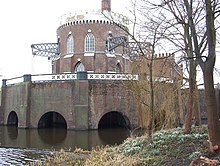



The Museum De Cruquius (or Cruquiusmuseum) occupies the old Cruquius steam pumping station in Cruquius, the Netherlands. It derives its name from Nicolaas Kruik (1678–1754), a Dutch land-surveyor and one of many promoters of a plan to pump the Haarlemmermeer (Haarlem lake) dry. Like many well-educated men of his time, he latinized his name to Nicolaus Samuel Cruquius. During his lifetime the issue of the Haarlem Lake and how to pump it dry was international news, as the following excerpt from the Virginia Gazette on 31 May 1751 illustrates:
- "By a private letter from Rotterdam, we are told, that the Dutch Engineers, in their Plan for draining the lake of Haerlem, proposed to employ 150 mills for three Years, and had computed the Expence at a Million and Half of Florins, but that a German, who had been long employed in the Mines of Hungary and Hartz, had proposed to drain it with 50 machines, in 15 months, at a far less Expence; and that he has been ordered to erect one of those Machines, which, if it shall be found to execute what he has asserted, his Proposal will be immediately accepted."
Even 50 machines proved too expensive, so it was not until successful experiments with steam pumping stations, such as at nearby Groenendaal park in 1781, that serious plans resulted in three steam-driven pumping stations, including the one at Cruquius. As a tribute to former planners, the pumping stations of the Haarlemmermeer were named after them. The one at the mouth of the Spaarne river, near Heemstede, was called Cruquius. To service the mill, the workers who lived there founded the town of the same name. The dike was built in the 1840s, the pump started work in 1850 and in the three years that had been predicted a century before, the Haarlem lake was pumped dry. The pumping station Cruquius continued to work on and off until 1933, when it was made into a museum. The foreman's house was made into a café which it still is today.